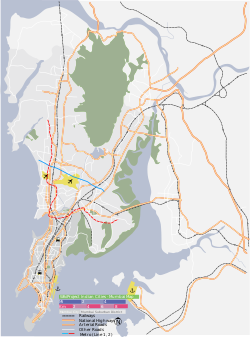| This article is written like a travel guide. Please help improve the article by introducing an encyclopedic style or move the content to Wikivoyage. (July 2020) |
Place in Maharashtra, India
| Crawford Market | |
|---|---|
| Commercial, Shopping | |
| Mahatma Jyotiba Phule Mandai | |
 View of Crawford Market View of Crawford Market | |
 | |
| Coordinates: 18°56′51″N 72°50′05″E / 18.947414°N 72.834710°E / 18.947414; 72.834710 | |
| Country | India |
| State | Maharashtra |
| District | Mumbai City |
| City | Mumbai |
| Founded by | Cowasji Jehangir |
| Government | |
| • Type | Municipal Corporation |
| • Body | Brihanmumbai Municipal Corporation (MCGM) |
| Language | |
| • Official | Marathi |
| Time zone | UTC+5:30 (IST) |
| Area code | 022 |
| Civic agency | BMC |

Crawford Market (officially Mahatma Jyotiba Phule Mandai) is one of South Mumbai's most famous markets. The building was completed in 1869, and donated to the city by Cowasji Jehangir. Originally named after Arthur Crawford, the first Municipal Commissioner of the city, the market was later renamed to honour Indian social reformer Mahatma Jotirao Phule. The market is situated opposite the Mumbai Police headquarters, just north of Chhatrapati Shivaji Terminus railway station and west of the J.J. flyover at a busy intersection. It was the main wholesale market for fruits in Mumbai until March 1996, when the wholesale traders were relocated to Navi Mumbai.
In 1882, the building was the first in India to be lit up by electricity.
Architecture
The market was designed by British architect William Emerson, and represented an early effort to blend Victorian Gothic architecture with indigenous elements. The market covers an area of 22,471 sq m (2,41,877 sq ft), of which 5,515 sq m (59,363 sq ft) is occupied by the building itself. The structure was built using coarse buff coloured Kurla stone, with redstone from Bassein. It has a 15 m high skylight awning designed to allow the sunlight to brighten up the marketplace.
The original design consisted of three doorways at the entrance, each divided with a column, with space for a carved panel depicting everyday life. Two such panels were carved by the artist, John Lockwood Kipling (the father of author Rudyard Kipling) depicting an image of workers working, but he was not able to complete the third before leaving India.
Timing
This market is mostly closed on Sundays. On other days, it's open from 11:00 am to 8:00 pm.
Items sold
The market houses numerous items, from wholesale fruits, vegetables and poultry to clothes, dress materials, toys, jewelry, and even a pet store. At the pet area, different varieties of dogs, cats, and birds can be found. There have also been stories of the illegal sale of endangered species.
Reaching there
Crawford market area can be reached by taking local trains from Masjid Railway Station, or local buses and cabs.
See also
References
- ^ Chopra, Preeti (2011). A Joint Enterprise: Indian Elites and the Making of British Bombay (NED - New ed.). University of Minnesota Press. doi:10.5749/j.ctttsrnj.6. ISBN 978-0-8166-7036-9.
- "Crawford Market". Archived from the original on 9 July 2012. Retrieved 18 June 2011.
- "Animal crackers at Crawford Market". Times of India. 28 March 2003. Retrieved 18 June 2011.
- Vora, Dhara (4 June 2011). "Buy your own Star Tortoise for Rs 600". Mid-Day. Retrieved 18 June 2011.
- A 137-Year Legacy; Times News Network, Times of India (Mumbai edition); 2006-03-25; pg-2
External links
| Pre-colonial | |
|---|---|
| Colonial |
|
| Beaches | |
| Places of worship |
|
| Cultural |
|
| Boulevards | |
| Districts | |
| Shopping |
|
| Buildings | |
| Parks, zoos and stadia | |
| Museums | |
| Forts |
|
| Restaurants & bars | |





